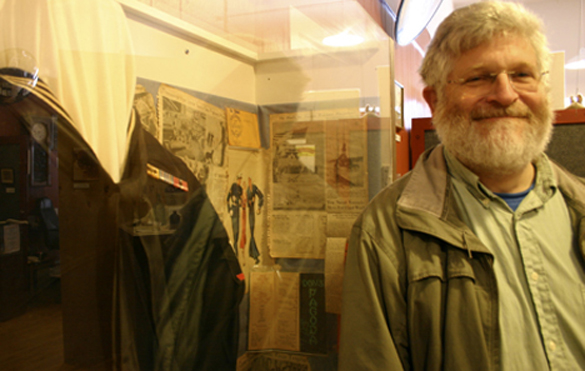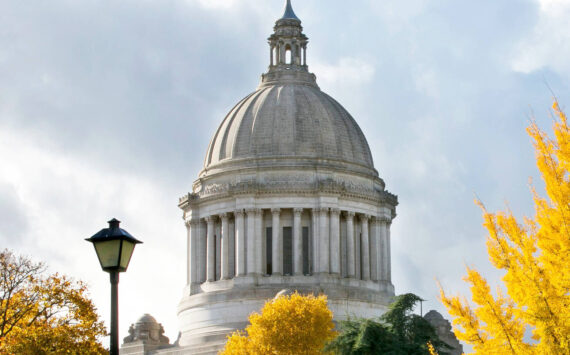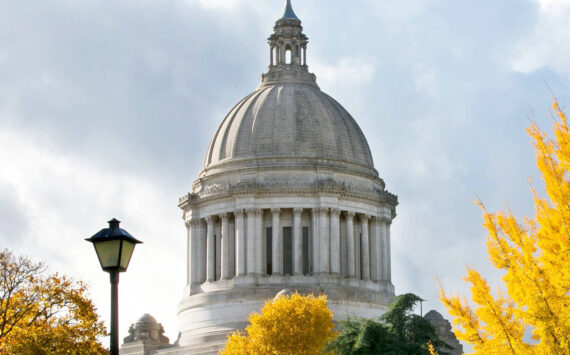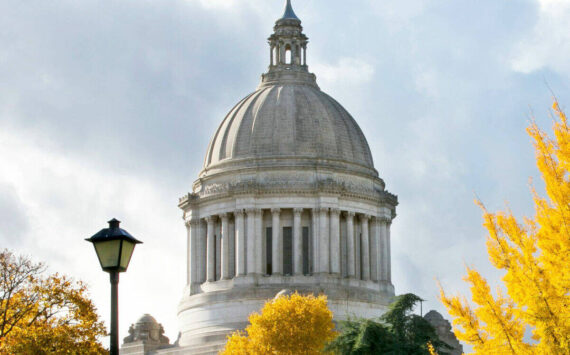Of the 200-plus photographs and artifacts that comprise “Shore Leave — Above the Tall Ships,” a collection currently on display at the Tacoma Historical Society’s downtown exhibit center, one photograph definitively captures the marvel and pride associated with maritime activities during the early Twentieth Century.
It’s an iconic scene — a fuzzy, black-and-white snapshot of Americana: a parade of sailors marching in perfect rows along a downtown street; thousands of parade watchers cover every available space of sidewalk; and a banner stretching across the width of the street welcomes the seagoing visitors.
But this isn’t any downtown street. It’s Tacoma’s Pacific Avenue 100 years ago.
“In my whole lifetime, I’m 52, I’ve never seen this many people in downtown Tacoma,” says Tacoma native and former City Councilmember Tom Stenger, whose collection of Tacoma memorabilia over the past 30-plus years makes up much of the exhibit. “We had the biggest parade.”
Indeed, between the early-1900s and the late-1940s, downtown Tacoma was a hub for visiting sailors — both military personnel and employees handling cargo for Northern Pacific. For many decades, the city’s economy centered on these men, and that meant brothels, bars, and live entertainment.
“People are dimly aware of [Tacoma’s shore leave history],” says Tacoma Historical Society President Jim Hoard. “You have to be fairly ancient like me to remember when downtown actually was lively, as these pictures reveal. During World War II, there were a lot of sailors around, and soldiers, too. That tended to disappear by the late-1940s.”
The exhibit, which is on display through Jan. 17, is organized in three themes. “We tried to look at some of the things you had to do, like visit the doctor and the dentist,” explains Stenger. “Then there are some of the things you wanted to do, like entertainment. And then there’s the cheap stuff — maximize your ability to see the town without spending a lot of money.”
Although the exhibit is largely a showcase of Stenger’s collection — including early souvenirs collected by Stenger’s great-grandmother and sold to sailors in town; many paintings of Mount Rainier, including one by Stenger’s great-great uncle, a Swedish journalist and painter named Fritz Colling; and enlarged postcards that depict downtown Tacoma between the 1920s and 1940s — it also includes some items from other society members. Director Mary Bowlby loaned a collection of medical instruments that a late doctor and ancestor kept in his black bag as he tended to sailors. Treasurer Marie Hayden offered the Navy uniform of her brother-in-law, Bob Hayden.
The exhibit also has a special section for one of the most significant maritime events in local history: the Great White Fleet’s visit to Tacoma in 1908. Photos show the fleet in Puget Sound and Commencement Bay, and the celebration that followed its arrival.
Even some of the seemingly incidental items — menus and place mats of popular diners; theater programs — give visitors a feel for what Tacoma was like for visiting sailors.
The Tacoma Historical Society’s exhibit center is located at 747 Broadway. It is open 12 p.m. to 5 p.m. Wednesday through Saturday. Donations are accepted as admission. For more information, visit tacomahistory.org.
The Tacoma Daily Index recently met Stenger for a tour of the exhibit.
TACOMA DAILY INDEX: One major feature of the exhibit is the Great White Fleet visiting Tacoma in 1908. Why is that significant?
TOM STENGER: President Theodore Roosevelt, after he succeeded as President, previously he had been the assistant secretary of the Navy. He had a big interest in the Navy. He built up the Navy. This was the same period of time that the United Kingdom built the Dreadnought, and they started a battleship war with the Germans over who would have the bigger battleships. So we got involved in that. What Theodore Roosevelt always said was speak softly and carry a big stick. So he thought he would build up the Atlantic fleet and send it around the world. This was a way of showing American strength around the world. Most of these people had never seen American warships before. They went down the eastern coast of Latin America and up the Western coast of Latin America. They went to San Francisco, and then they came to Tacoma. We went crazy.
INDEX: Did Tacoma offer something unique or different than other port cities? Was there competition between cities for sailors and their business?
STENGER: The competition was more between the shipping firms. Sailors didn’t have a choice what port they went to. The shipping firms would compete back and forth. It depended upon if you were in the shipping business and your main contact was the Northern Pacific or the Great Northern. If you had joint rates or did business with the Great Northern, you were in Seattle. If you were doing business with the Northern Pacific and had joint rates, you would end up here in Tacoma. Northern Pacific had a big share of the wheat business and logging business. Whereas Great Northern had much more of the imports.
INDEX: Do you have a sense of how much downtown’s economy relied on sailors?
STENGER: I think it was significant. The downtown economy was largely based on the interests of single men. With the logging business, it was seasonal work. Mills were seasonal because logging was seasonal. So you had all these guys who weren’t working during the winter, and every town wants those guys to hole up in their town so they would be paying rent, paying board, buying food. So different towns competed. The competition was to be an open town — to allow anything goes for mens’ entertainment. People who were the closed town forces that didn’t want anything goes were often accused of being anti-business. Tacoma was definitely an open town. We did things like dance halls would have special rates for sailors. The restaurants would have a special cut rate meal to show their support. Tacoma just loved the Navy here. I think moreso because Fort Lewis is so many miles away. I think it was much more of a consciousness of the Navy and the need for the Navy that people in Tacoma necessarily feel about Fort Lewis right now. It was a real intensity. It was something everyone agreed on.
INDEX: How long did sailors stay in Tacoma?
STENGER: It sometimes depended on the efficiency of the shipping line. If you immediately had another cargo to load or unloading something and then had to go to another port, you were in and out in less than a week. But depending on how much business there was, it might be slow.
INDEX: When did shore leave activity die off?
STENGER: It never really came back after World War II. What happened was you had the Missouri up there in Bremerton. So if you wanted to go see the ships, you would go up to the Bremerton Naval yard and see the ships. We never got the investment [like Everett] to have a pier and stuff up there. That was a big project of Henry Jackson. Also, with the development of the Port of Tacoma, the docks got further away from downtown. So you had those taverns like Barnacle Bills or whatever out in the port district that I think catered more toward the men that worked out there, and then led to the Tacoma Seamens Mission out there at the port. There wasn’t so much people coming down here to downtown Tacoma. And then in 1952 we changed the form of government. We shut down the whorehouses, the town cleaned up, there was not as much interest. If you wanted to do that sort of thing, you had to go to Aberdeen.


Todd Matthews is editor of the Tacoma Daily Index and recipient of an award for Outstanding Achievement in Media from the Washington State Department of Archaeology and Historic Preservation for his work covering historic preservation in Tacoma and Pierce County. He has earned four awards from the Society of Professional Journalists, including third-place honors for his feature article about the University of Washington’s Innocence Project; first-place honors for his feature article about Seattle’s bike messengers; third-place honors for his feature interview with Prison Legal News founder Paul Wright; and second-place honors for his feature article about whistle-blowers in Washington State. His work has also appeared in All About Jazz, City Arts Tacoma, Earshot Jazz, Homeland Security Today, Jazz Steps, Journal of the San Juans, Lynnwood-Mountlake Terrace Enterprise, Prison Legal News, Rain Taxi, Real Change, Seattle Business Monthly, Seattle magazine, Tablet, Washington CEO, Washington Law & Politics, and Washington Free Press. He is a graduate of the University of Washington and holds a bachelor’s degree in communications. His journalism is collected online at wahmee.com.








